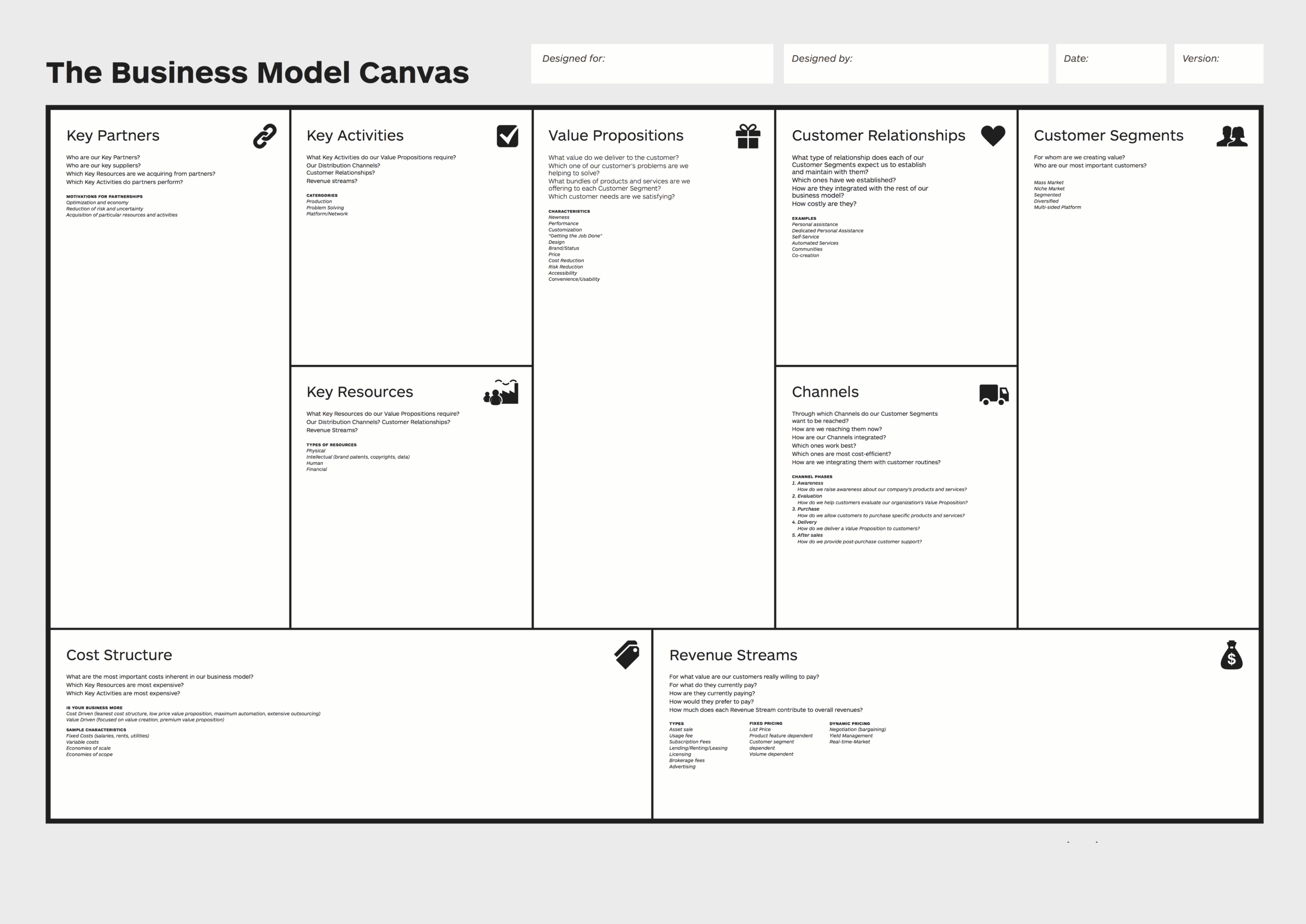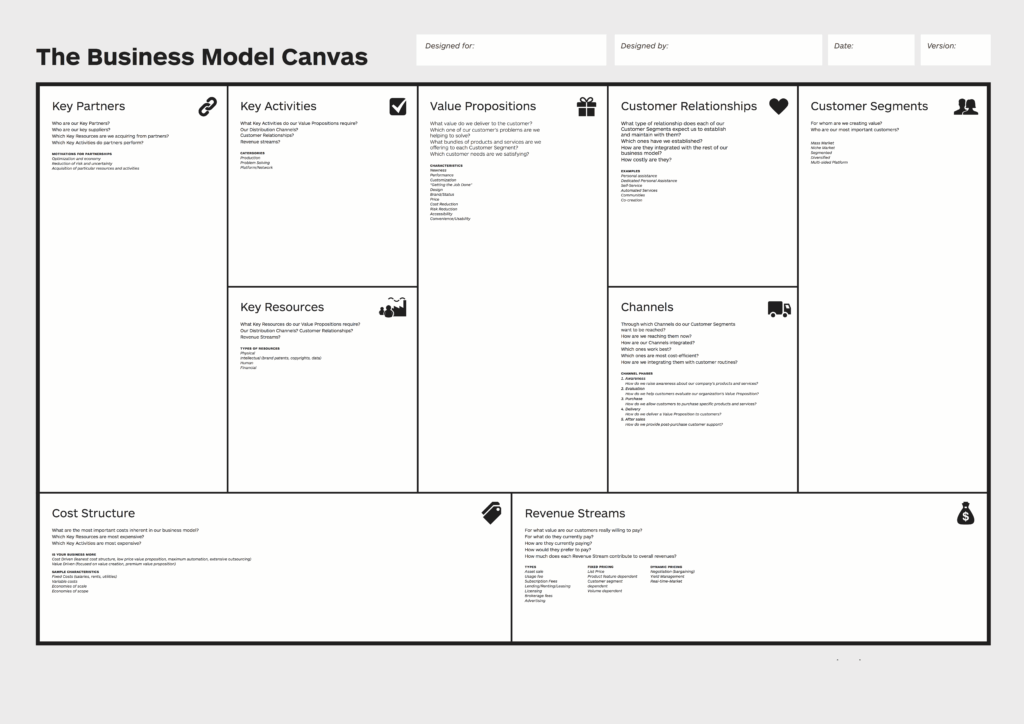Let’s be honest:
Most business plans look like they were written by someone trying to impress a bored bank manager. You know the type—40 pages of buzzwords, zero clarity, and by the end you’re still wondering, “What exactly do they do?”
Now imagine if you could strip away all the noise and see your business—really see it—on a single page. One tool. Nine building blocks. No fluff. That’s the Business Model Canvas.
And if you’re not using it, you’re flying blind in a storm without instruments. Let’s fix that.
Why the Business Model Canvas Works (When Nothing Else Does)
The canvas is elegant. Ruthless. Brutally clear. It forces you to answer the questions most entrepreneurs are too busy (or too scared) to face.
Where’s the money coming from?
Who are you actually serving?
Why should anyone give a damn?
How do you deliver the goods without lighting your budget on fire?
That’s what the canvas solves. It’s not theory. It’s the street map to survival.
History Has a Funny Way of Rewarding Simplicity
Let’s rewind.
In 1917, Henry Ford wasn’t sitting around drafting a 50-page pitch deck for investors. He was streamlining production lines, driving down costs, and cranking out Model Ts faster than America could say “horseless carriage.” His business model was visible. You could see it. Understand it. Replicate it.
Fast forward. Sam Walton didn’t invent retail—he reinvented margins. He created a model where volume crushed price, and logistics ran tighter than a military drill. Again, visible. Simple. Ruthless.
Great businesses don’t hide behind buzzwords. They show their model. And that’s exactly what the canvas does.
Let’s Tear Through the 9 Blocks Like a Business Surgeon
1. Customer Segments:
You are not for everyone. Get that tattooed on your forehead.
Identify your tribe. Serve them like kings. Ignore the rest. Starbucks doesn’t market to truck drivers. Harley doesn’t market to accountants. Know your people.
2. Value Proposition:
What problem are you solving? No fluff. No adjectives.
Airbnb made travel personal. FedEx promised “overnight or it’s free.” Domino’s made a billion dollars on “30 minutes or less.”
What’s your 7-word pitch that makes people say, “Shut up and take my money”?
3. Channels:
How do you reach them?
Website? Store? App? Email? Skywriting?
It’s not about how cool the channel is. It’s about how fast it gets you in their pocket, inbox, or brain.
4. Customer Relationships:
Automation is nice. Loyalty is better.
You don’t want one-time customers. You want raving fans. You want people wearing your logo on their chest while arguing with strangers about how great your product is.
5. Revenue Streams:
Let’s not get shy here. How do you make money?
One-time sale? Subscription? Licensing? Freemium upsell?
Michelin sold more tires by publishing a travel guide. Wrap your head around that.
6. Key Resources:
What are your power tools? Tech? Talent? Data?
Amazon doesn’t just have warehouses—they have the logistics of a military empire.
Own your advantage. Guard it like a dragon hoards gold.
7. Key Activities:
What must you do better than anyone else?
Netflix creates and licenses content. Tesla builds electric cars—and headlines.
Don’t get distracted. Do your “one thing” brilliantly.
8. Key Partnerships:
You can’t do it alone.
Apple needs Foxconn. Nike needs manufacturers. McDonald’s needs real estate.
Build alliances that sharpen your sword, not ones that waste your calendar.
9. Cost Structure:
Where’s the burn?
Fixed vs. variable. Lean vs. bloated.
Know every dollar like it’s your last lifeline. You don’t want to discover your burn rate when your card declines.
This Isn’t a Canvas. It’s a Mirror.
Most people look at the Business Model Canvas like it’s a worksheet. Wrong.
It’s a mirror. And most entrepreneurs don’t like what they see.
Are your value propositions weak? Customers unclear? Channels outdated?
This canvas will expose every crack in your foundation—and that’s a good thing.
Better to catch it now, on paper, than when you’re knee-deep in unpaid invoices and ghosted customers.
Here’s the Real Deal:
If you can’t explain your business on a napkin, you don’t have a business—you have a hobby with expenses.
The Business Model Canvas is the cure for complexity.
It’s the sharp blade that cuts through confusion.
It’s the one-page MBA that doesn’t cost you your soul or your savings.
Use it. Refine it. Revisit it monthly. Weekly if you’re in startup mode. It’s your compass in a world of shiny objects and bad advice.
Final Word?
The Business Model Canvas won’t make your business successful.
But it will make it clear.
And clarity? That’s where success begins.
Now go.
Sketch.
Tear your idea apart.
Then rebuild it stronger, smarter, and far more profitable than it was yesterday.
Author
-

He's a talented Project Director @Brightery, studied in different colleges and working with Udjat UAE as CMO, writes in Project Management, Marketing, Digital Marketing and technical software development.





